R111 | 1999-2001
the transformation of
digital information to
analog matter
“R111 could be considered the pinnacle of
Yukiko Shikata, President of International Association of Art Critics Japan, 2024
media art at the turn of the millennium.”
Exploring Information as the
Ultimate State of Matter
In early 1666, when he was just 19 years old, Gottfried Leibniz authored the book “Dissertatio de Arte Combinatoria.” His objective in this work was to distill all forms of reasoning and discovery into a combination of fundamental elements, including numbers, letters, sounds, and colors. Inspired by the ideas of past philosophers like Ramon Llull, Leibniz introduced a framework for the alphabet of human thought. He contended that all concepts were compositions of a limited set of basic concepts, akin to how words are constructed from letters. Leibniz proposed that truths could be articulated through suitable arrangements of concepts, which could, in turn, be broken down into fundamental ideas. He also discovered the binary system, which serves as the cornerstone of the digital universe.
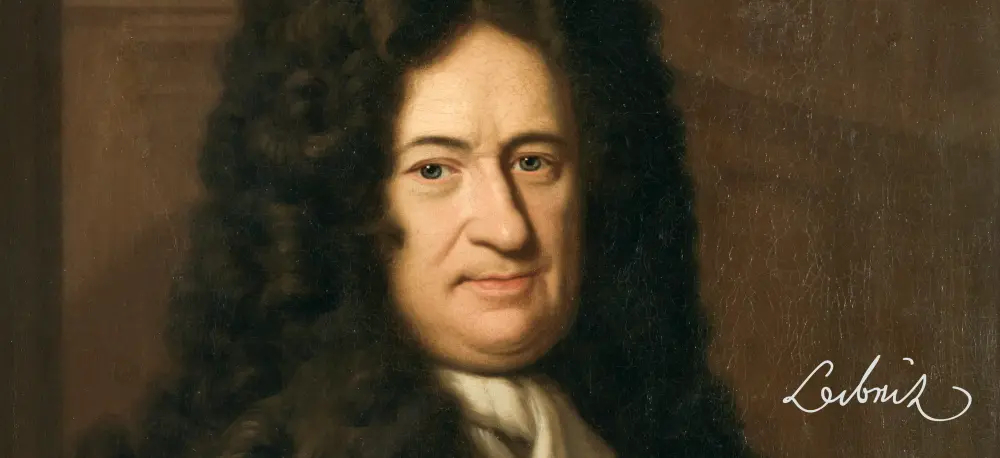
“I virtualna je stvarnost tijelom (materijom) postala i prebivala meðu nama.”
“And virtual reality became embodied (materialized) and dwelled among us.”
In 1999, every time a book was ordered online, a lump of coal was burned. It required approximately one pound of coal to facilitate the creation, packaging, storage, and transportation of two megabytes of data, equivalent to downloading two minutes of music from the internet. While futurists had envisioned information highways and fiber-optic cables, the reality included unit trains laden with coal and 600-kilovolt power lines. The future, it seems, would involve both.
At R111, energy potentials are harvested from the internet and the movement of spectators in physical space. These energies are then converted into various states of matter, both physical and virtual, and showcased through multiple modules within the installation. While new media trends tend to virtualize reality, R111 reverses this process by materializing virtuality, showcasing its appetite for electrical power: choreographing particles of matter via energy as though they were pixels.
The aggregate state of Information Propagates Through the Medium of Energy
Visitors can engage in activities where they experience the generation and conversion of energies, spanning from virtual realms to tangible material changes, all of which interact with one another. The energies inherent in the physical world, which we harness and perceive, are transposed into the realm of information and networks, which form the foundation of today’s information-driven society. In a landscape where every tangible reality can be processed as data, how do we detect the energies embedded within information, including intellectual, mental, and economic prowess?
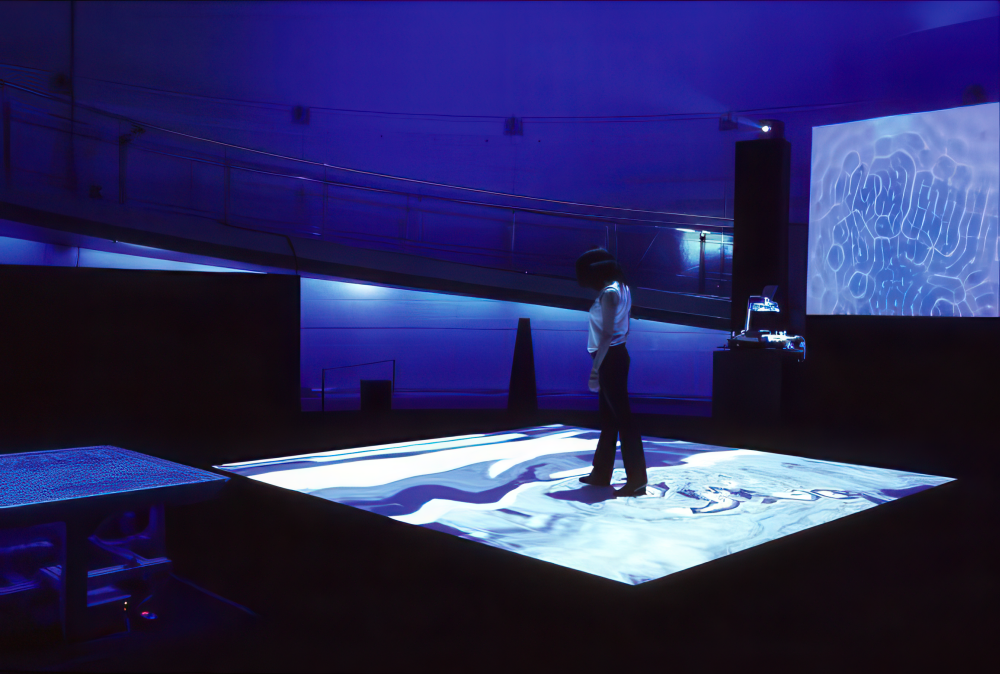
Physical interfaces
The sonic floor serves as the primary local interface within the installation. Spectators can walk on top of it, experiencing a unique interaction. Comprised of a subwoofer matrix, the sonic floor emits energy in the form of vibrational forces generated by infrasonic sound waves, which are felt by the spectator. Additionally, any movement on the sonic floor is tracked by a motion-tracking camera, thus generating energy for the system through the spectator’s motion. These movements leave traces on a liquid surface projected onto the sonic floor, enhancing the immersive experience.
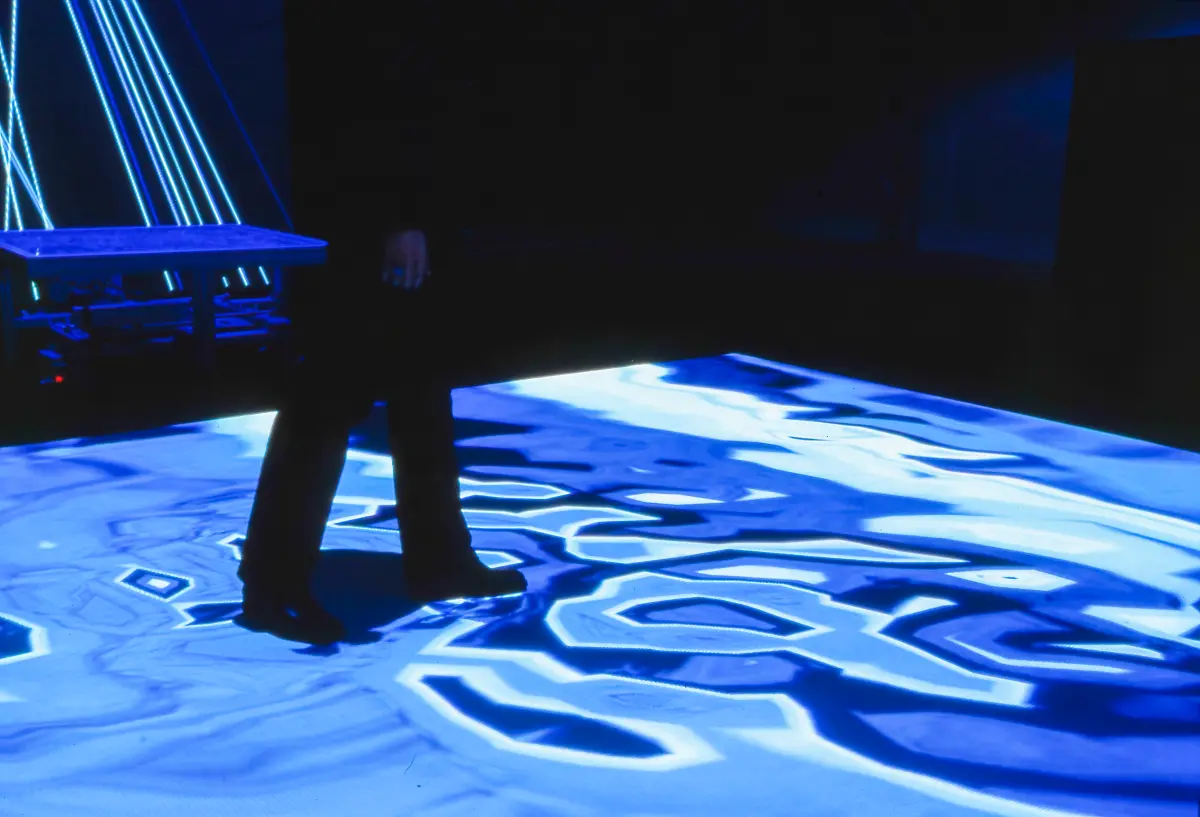
The liquid module is composed of a platform containing silicon oil, designed to respond to audio stimuli. This platform is connected to audio speakers in such a manner that sound vibrations cause the liquid to move. Through this arrangement, the system’s energies can be visually represented using liquid media. The movements of the liquid surface are then projected onto a wall via an overhead unit, allowing spectators to observe and engage with the dynamic display of energy transformations.
The magnetic module comprises a matrix of magnets situated beneath a metallic platform. On this platform, various sizes of granular media, such as steel balls, are arranged. This configuration enables the creation of structures that visually represent the system’s directional energy through the reorganization of the granular media. As the magnets influence the movement and alignment of the granular materials, spectators can observe and interpret the dynamic manifestations of energy within the system.
The network sensors within R111 operate through a concept known as data cannibalism, facilitated by tools like the web data cannibal, virtual motion tracker, and semantic vectors. The web data cannibal serves as a virtual “eye” delving into the depths of the internet, producing IP numbers within its IP factory and assessing website content in tandem. These findings undergo classification into energy potentials through the utilization of Advanced Information Retrieval (AIR). Developed by Canon Inc., AIR represents an AI system designed for semantic vector analysis, specifically crafted for this purpose with proprietary and specialized technology. Semantic vector analysis is a computational technique used to analyze and understand the meaning of words, phrases, or documents based on their relationships in a high-dimensional semantic space.
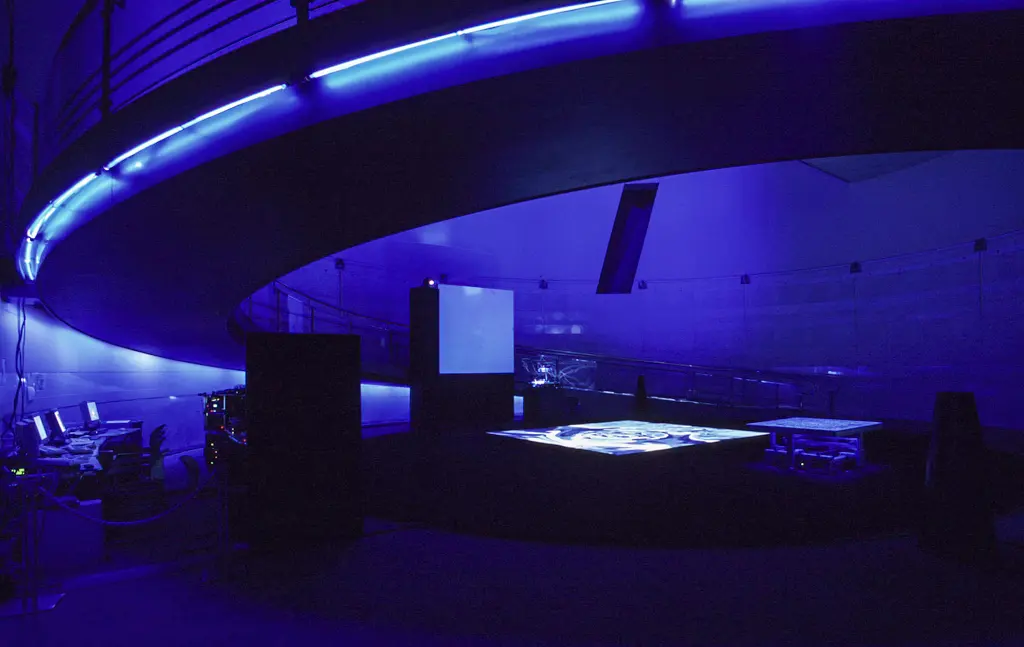
Spectators can actively contribute energy to R111 via the virtual motion tracker interface on the R111 webpage, further enhancing the system’s dynamics. Additionally, a touch-screen displaying the virtual motion tracker interface is available within the exhibition space for direct engagement.
In the virtual realm of R111, the collective intelligence of the system is represented, with incoming energy potentials visualized through an ever-burning interactive blue fire within IP-coordinate space, centered around 0.0.0.0 – the absolute zero of the 4-dimensional IP universe. This dynamic visualization provides insight into the system’s operation and the flow of energy within. It classifies the internet as a perpetually ablaze entity, an eternal inferno, revealing the true cost of data: the sustenance of the infossil era by the fossil strata of the Earth.
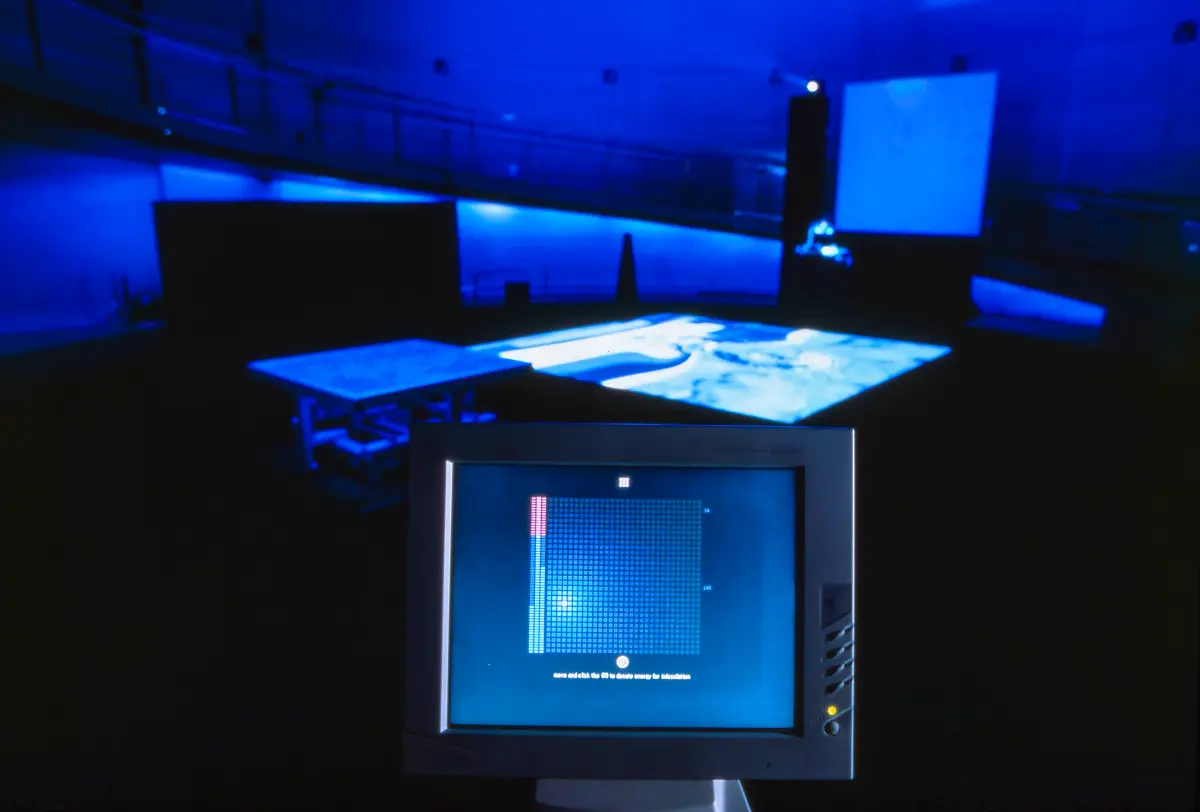
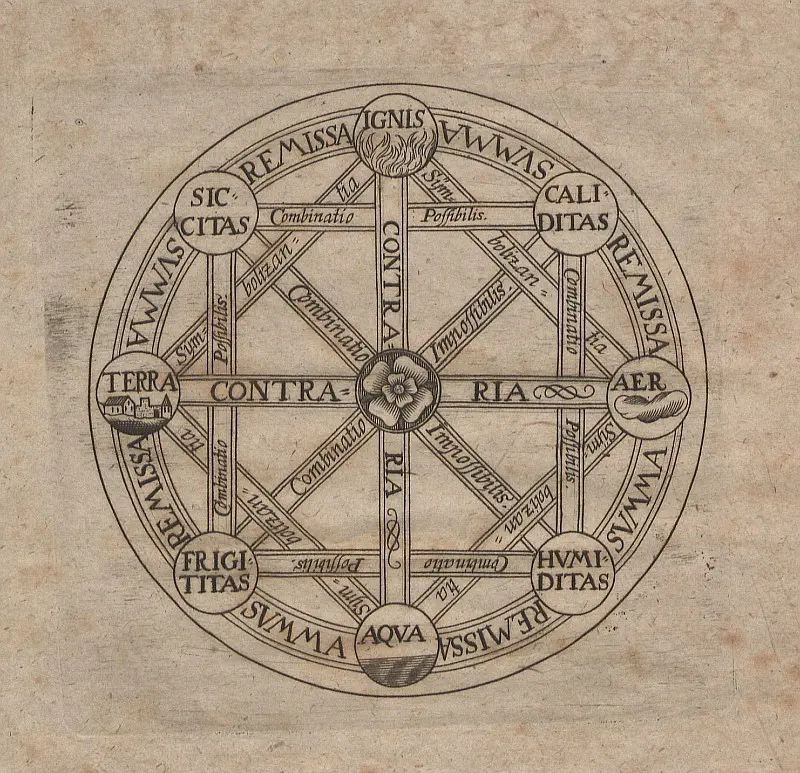
exploring energy as
the ultimate medium
within the Fabric
of the Universe
アートラボ第5回プロスペクト展「R111 —仮想から物質へ」
アーティスト:ミヒャエル・サウプ+supreme particles(ドイツ)
会期:2001年6月1日 – 17日
会場:スパイラルガーデン(東京・南青山)
主催:キヤノン株式会社アートラボ
後援:ドイツ連邦共和国大使館、東京ドイツ文化センター
協力:株式会社ワコールアートセンター、ファストネット株式会社
協賛:日本SGI株式会社、キヤノン・スーパーコンピューティングS.I.株式会社。ハーマンインターナショナル株式会社
キュレーター:阿部一直+四方幸子(キヤノン・アートラボ)
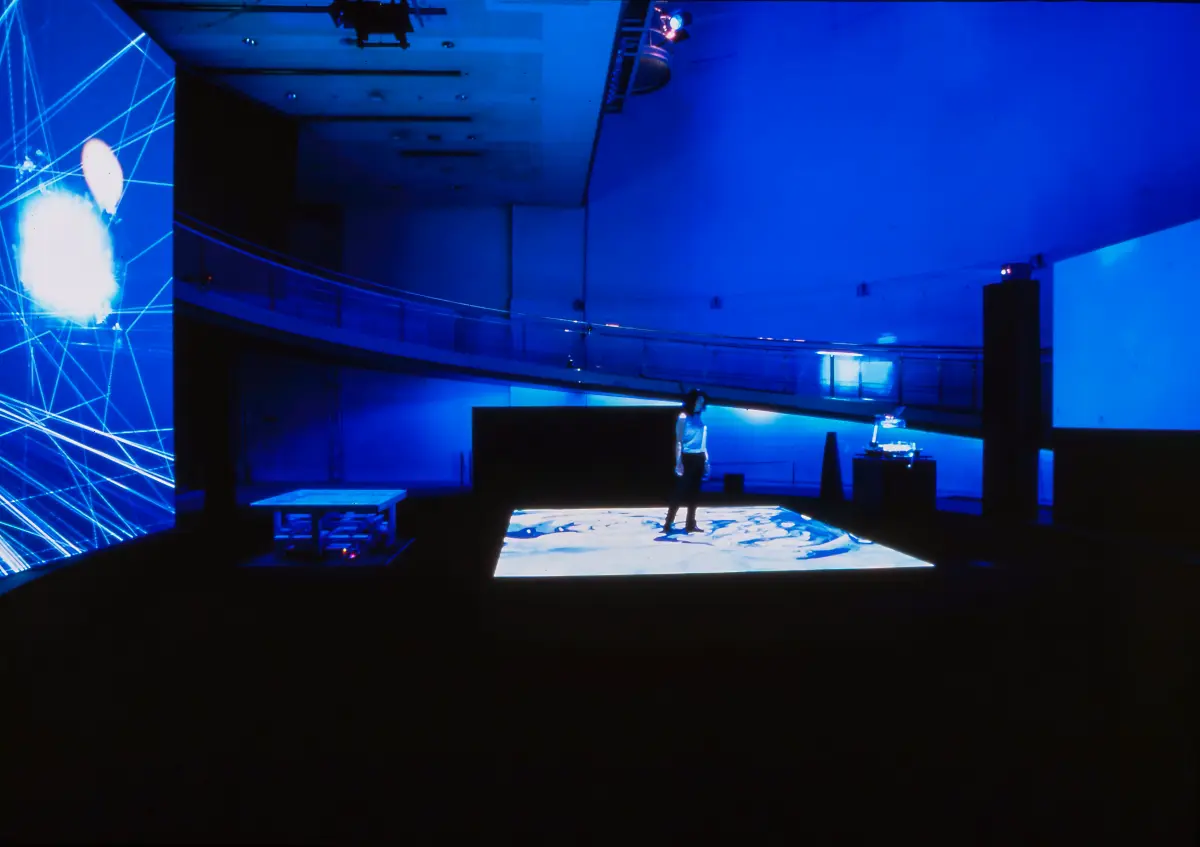
「R111」は、人の動き、磁気やシリコンオイルなどの物質の形態変化やそれらとリンクした仮想空間、そしてインターネットなどを領域を超えて稼働する潜在的エネルギーと見なし、エネルギーが様々な形で転移していく様を視覚・音響的に体験させる作品である。
フロア上で体験者が動くと、水のような波紋がサウンドを伴い揺らぎ、触覚的に迫ってくる。体験者の動き、会場の端末や遠隔からアクセスする参加者の操作、ウェブロボットが無作為に抽出したホームページの情報などがエネルギーとして分析され加えられていく。
正面のスクリーンでは、それらエネルギーが統合されたCGによる<仮想>世界が変動していく。情報空間上のエネルギーは、会場に設置された磁場を視覚化した装置(磁気モジュール)やシリコンオイルの波紋(リキッドモジュール)の形態変化へ伝搬していく。
「R111」では、様々な要素:物質/テキスト、現実/仮想空間が複雑に絡み合い、エネルギーが循環し転移する様が表現される。本作はサウプと彼が率いるsupreme particleによる同名作品を、キヤノンとのコラボレーションによって特別なバージョンアップ版としたもの。「R111」は、1920年代のオスカー・フィッシンガーの実験映画「R1」と二進法で7を表す「111」による造語。サウプは、フィッシンガーと二進法の発案である哲学者ライプニッツを、あらゆる存在が情報化されていく現在のマルチメディア・ネットワークの発想の先駆と見なしている。
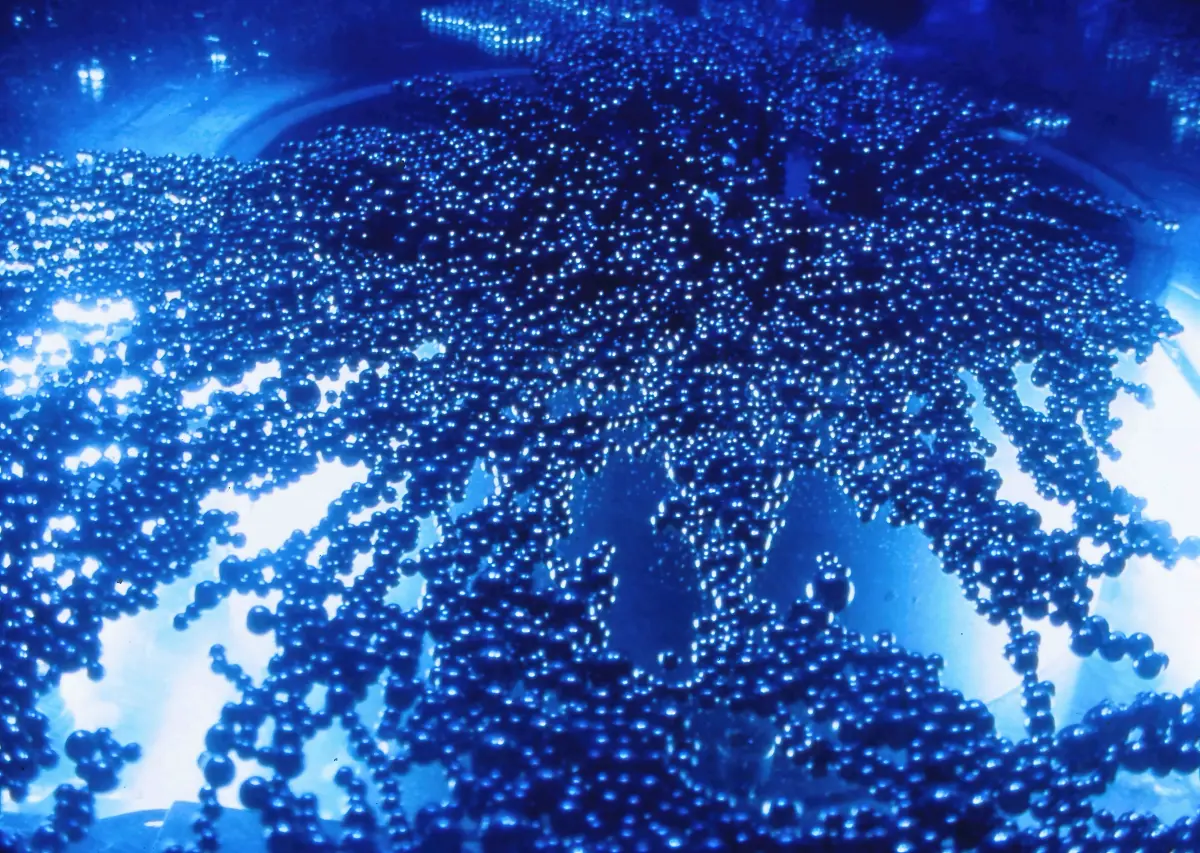
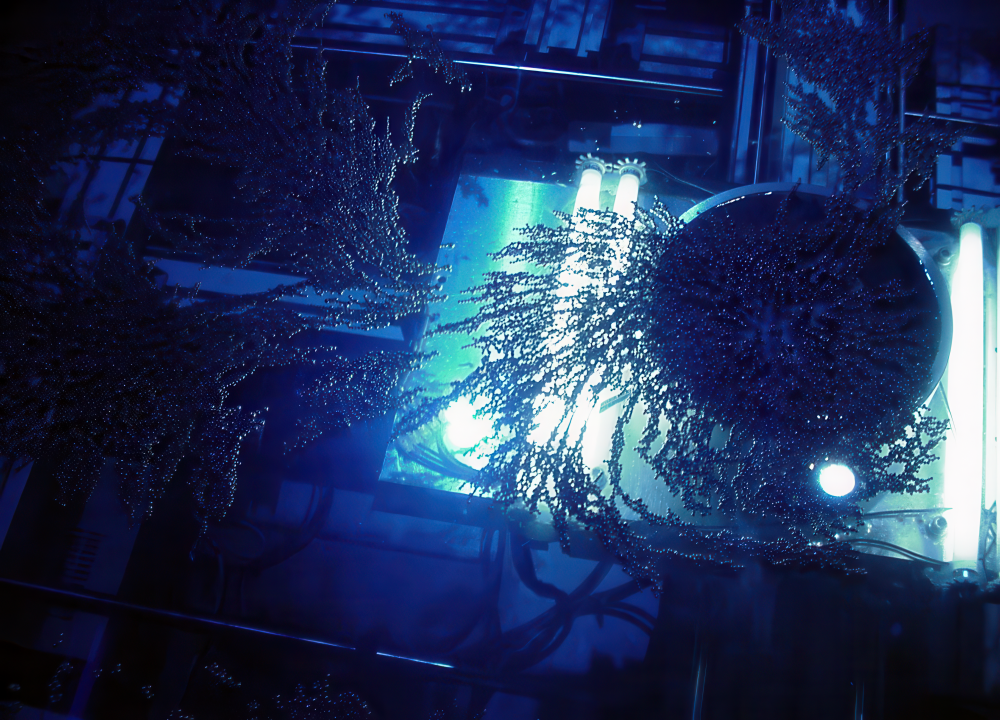
*本作のウェブロボットによるインターネット検索は、キヤノンが開発した知的情報検索技術を加えることで、新しいバージョンとした。またキヤノンのライブ映像発信システム「WebViewLivescope」を使い、体験者が作品形成に関わった様子をインターネットユーザーが遠隔的に体験することができた。
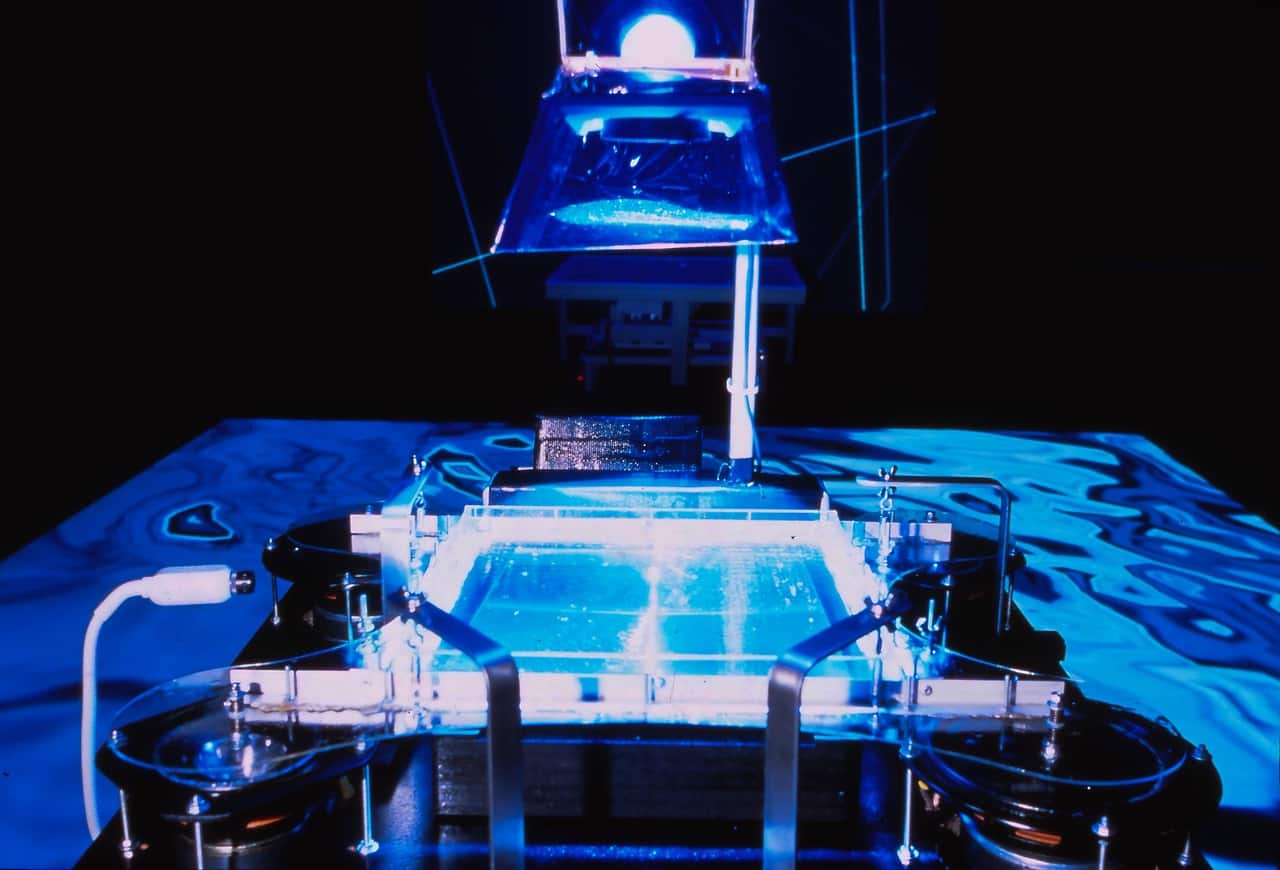
「キヤノン・アートラボ」は、科学と芸術の融合による新たなアート領域の創造をめざす実験的な場として1990-2001年に存在したキヤノン株式会社の文化支援プログラム。アーティストとソフトウェア・エンジニアとの約10カ月のコラボレーションによりメディアアートの新作を発表、それらの多くが国内外を巡回、アップグレードも継続的に行った。実施した展覧会は、合計17(企画展10、海外から作品を招聘するプロスペクト展5、オープン・コラボレーション展1、特別展1)。その他にカタログを始めとした出版、シンポジウムやトーク、機器サポート、資金サポートなどを行なった。
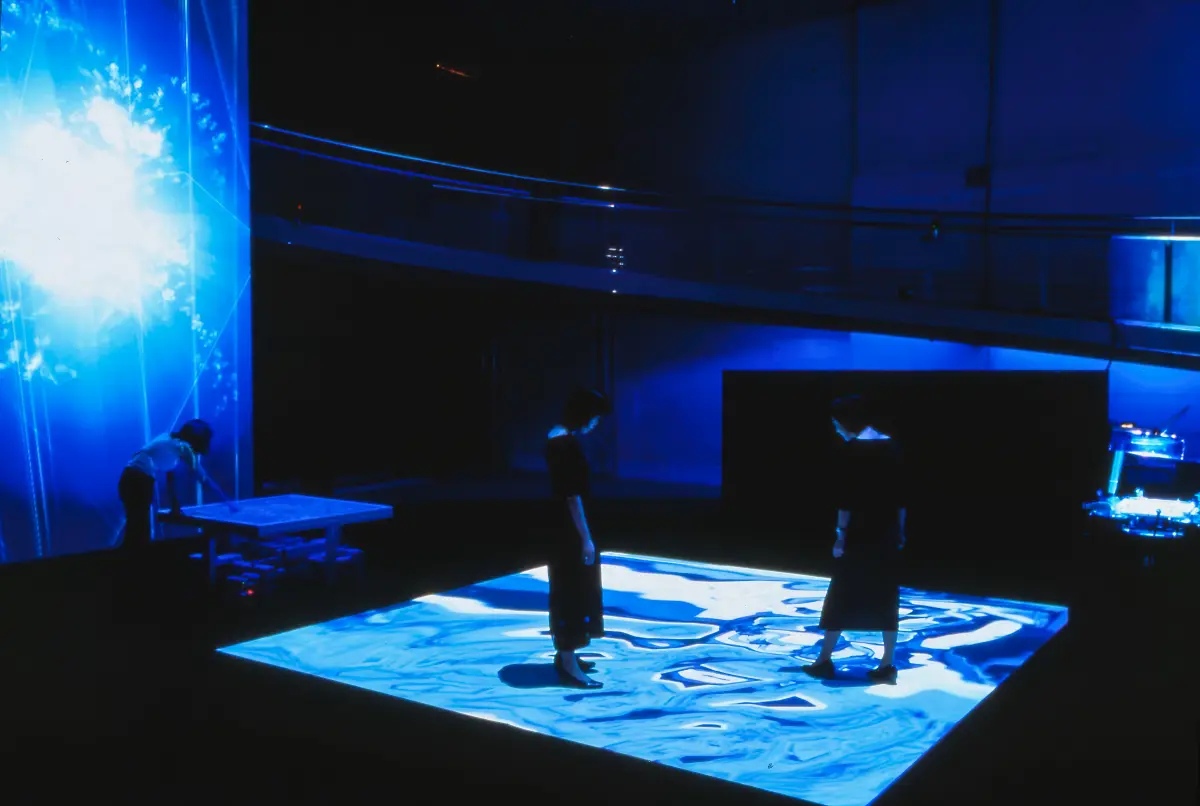
Analogously, the numerous iterations of the spatially encompassing interactive environment R111 (1996–2001) transduced human presence into nonhuman materialities. “Energy potentials” were, in Saup’s words, “cannibalized off the Internet and from the local movement of spectators . . . and then transformed into various states of matter — both physical and virtual — and presented by the installation with the help of physical and virtual modules” (figure 8.5). Harnessing data from a wide range of sources, R111 provocatively fused the computation and physical, “choreographing particles of matter as if they were pixels” and translated gathered “sensations” not only into the typical interactive liquid morph of the image, but also into the physical waves of infrasonic sound, the vibration of silicon oil, and the shifting of magnetic particles, all installed on tables in the space (Saup 1999).
Chris Salter, Entangled: Technology and the Transformation of Performance, MIT Press 2010

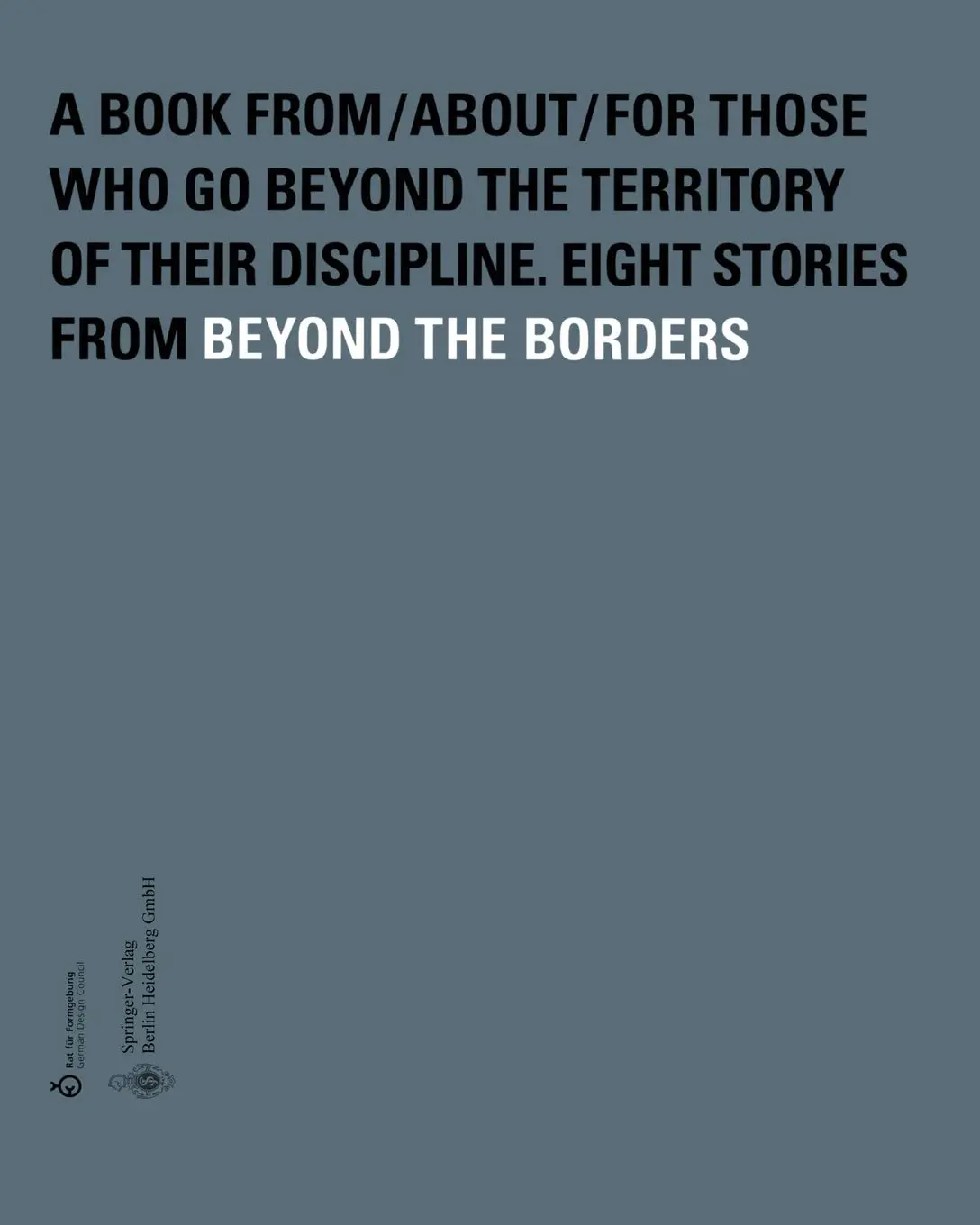
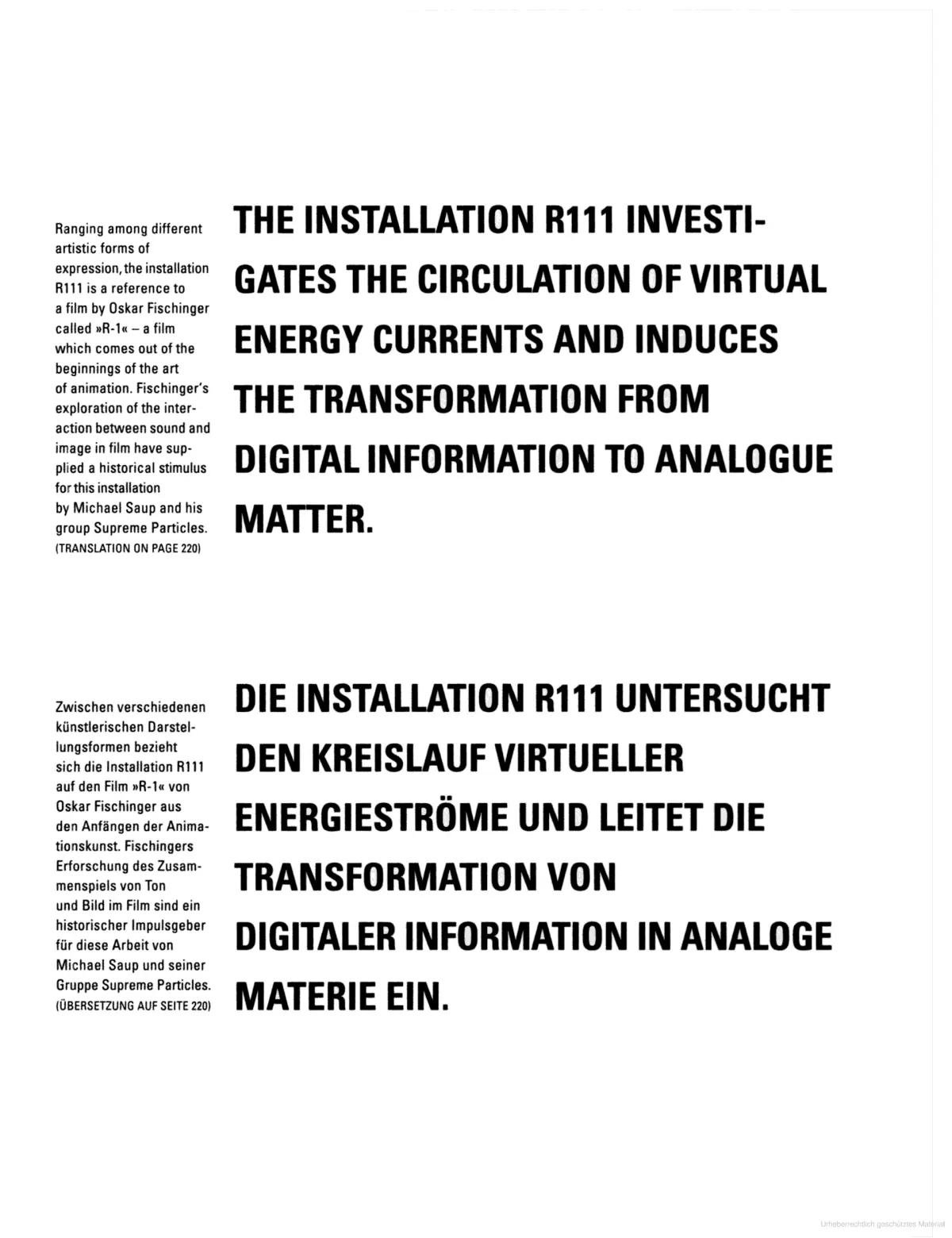
Can imagination be transformed into reality? How can we translate thoughts into tangible experiences? Is it feasible to convert fantasies into a series of tangible sensations? Moreover, how can we bridge the virtual realm and its energy with our physical reality? These are just some of the inquiries that emerged during the captivating presentations held on December 13 and 14 2001 at the MM-center of SC, featuring media installations by the German guru in media and new technologies, Michael Saup.
…The video installations, characterized by their intricate complexity, effectively embody the seemingly straightforward aspiration to translate the latent energy within digital imagery into palpable, physical forms, thereby allowing participants to actively engage with the artwork. For instance, in the installation R111, set upon a vast sound stage adorned with digital projection, participants manipulate the environment with their movements, eliciting distinct graphic sensations and effectively “playing” with the installation. As the artist himself articulates, the screen constantly evolves, presenting an array of graphic sensations and newly generated images and sounds, facilitated by the intricate workings of millions of computer chips and fluid structures. In the second project, Plasma, observers can directly influence both the sound and imagery through their movements, engendering a symbiotic digital dialogue with their alter-ego. Plasma serves as a prime example of the seamless conversion of virtual energy into tangible material, encapsulated in the digital manifestation of “supreme particles.”
…I’ll highlight just one alarming statistic that Michael Saup shared during his lecture: Currently, a staggering 20% of the world’s total energy consumption is attributed to computers and the internet. This raises concerns about the voracious appetite of what we commonly refer to as “virtual reality.” However, providing a definitive answer to this question, along with the myriad others posed throughout this discourse, remains elusive. Yet, in the meantime, we can reflect on, interpret, and experience these issues to varying degrees. This contemplation is encapsulated in the immersive auditory and visual experience crafted by Michael Saup at MM: “And virtual reality became embodied (materialized) and dwelled among us.” – “I virtualna je stvarnost tijelom (materijom) postala i prebivala meðu nama.”
Marijan Krivak, 2000 | http://www.zarez.hr/system/issue/pdf/377/045-046.pdf
SHOWS
- 1999, June 20 – August 1, Connected Cities: Processes of Art in the Urban Network : Wilhelm Lehmbruck Museum Duisburg and Selected Sites of Industrial Culture, Lindenbrauerei Unna, Germany, curated by Söke Dinkla
- 2000, March 13 – 18, Les Nouveaux Nouveaux Mondes, Maison des arts de Créteil, Paris, France, curated by Richard Castelli
- 2000, Le Pass (Parc d’Aventures Scientifiques) Science Park, Frameries, Belgium, curated by Richard Castelli and Benoit Dave
- 2001, June 1 – 17, Canon ARTLAB Prospect 5, Tokyo, Japan, curated by Yukiko Shikata & Kazunao Abe
- 2006, May 13 – 21, Kunst Computer Werke, ZKM, Karlsruhe, Germany, curated by Oliver K. Boeg
CREDITS
Supreme Particles
R111
1999–2001
Concept and Artistic Direction:
Michael Saup
Contributors, Version Connected Cities, Unna 1999:
Pino Grzybowsky, Steffen Ruyl Cramer, Marc Kaiser, Lars Werbeck, Gerhard Stäbler, Jan Totzek, Stefan Hofmann, Armin Purkrabek, Timo Piatkowski, Gideon May, Katharina Gsöllpointner, Karl von der Linden, Bodo Lensch, Anne Niemetz, Steffen Wolf
Contributors, Version Canon ARTLAB, Tokyo 2001:
Pino Grzybowsky, Norman Muller, Louis Philippe Demers, Julie Méalin, Jan Totzek, Daniel Verhülsdonk, Dominik Rinnhofer, Stefan Preuß, Julia Herzog
Canon ARTLAB 2001:
Yukiharu Mizuuchi, Shinichi Tenno, Hiroyuki Kimura, Shun’Ichi Tamai, Shinko Sugiyama, Yoshinori Shindo, Hirokazu Akisada, Hiromi Bessho, Tomoyuki Isonuma, Hironori Goto
Reconstruction, ZKM 2006:
Gisbert Laaber, Peter Gather, Manuel Weber, Martin Haeberle
Curatorial Support:
Söke Dinkla (Wilhelm Lehmbruck Museum Duisburg, Connected Cities, 1999)
Richard Castelli (Epidemic, Les Nouveaux Nouveaux Mondes, 2000)
Benoît Dave (Le Pass Frameries, Parc d’Aventures Scientifiques, 2000)
Yukiko Shikata & Kazunao Abe (Canon ARTLAB, Prospect 5, 2001)
Oliver K. Boeg (Kunst Computer Werke, 2006)
Margit Rosen (ZKM, 2025)
Production Sites:
Karlsruhe, Unna, Frameries, Paris, Tokyo
Inspired by Dig more Coal – the PCs are coming – an article by Peter W. Huber 1999 and R1 by Oskar Fischinger 1927
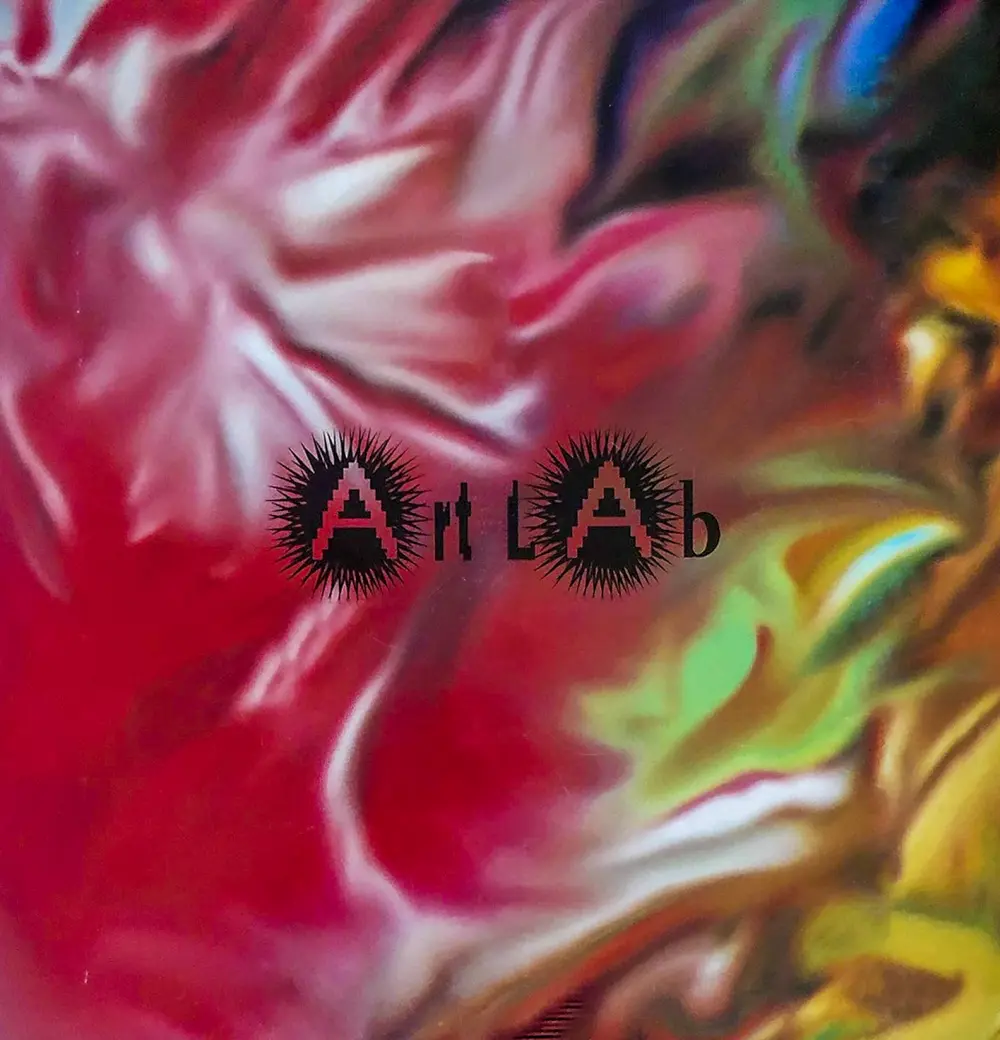
Venue: Spiral Garden (Minami-aoyama, Tokyo)
Organizer: ARTLAB, Canon Inc.
Support: Embassy of the Federal Republic of Germany, Goethe Institut Tokyo
Co-operation: Spiral/Wacoal Art Center, Fast Net Inc.
Sponsors: SGI Japan, Ltd., Canon Supercomputing S.I. Inc., harman international
Curators: Kazunao Abe + Yukiko Shikata (Canon ARTLAB)
Canon ARTLAB (1990-2001) was the cultural support program by Canon Inc., to produce new work of media art by the collaboration between artists and Canon’s computer engineers. ARTLAB produced totally 17 exhibitions and most of the work were further upgraded and toured worldwide. Other activities; publication, symposium and talk, equipment support and financial support.
Loan to the ZKM Karlsruhe 2006 – today
LINKS
- Yukiko Shikata’s archive: http://yukikoshikata.com/al-pros5-r111-仮想から物質へ/
- International Association of Art Critics Japan: https://critique-aicajapan-com.translate.goog/6396?_x_tr_sl=ja&_x_tr_tl=en&_x_tr_hl=en&_x_tr_pto=wapp
- Ars Electronica Award: https://archive.aec.at/prix/showmode/38533/
- https://archive.aec.at/media/assets/1cc0956026771d53e55a6beccddabe85.pdf
- http://netzspannung.org/cat/servlet/CatServlet?cmd=netzkollektor&subCommand=showEntry&lang=en&entryId=148288
- https://spatialinteractions.wordpress.com/2011/09/30/r111/
- https://neural.it/2001/06/r111/
- http://personales.upv.es/moimacar/pages/catalog/03/r111.htm
- https://academic.oup.com/mit-press-scholarship-online/book/20595/chapter-abstract/179884955?redirectedFrom=fulltext
- https://books.google.cz/books?id=SXHqxHlBTJkC&pg=PP125&lpg=PP125&dq=R111+saup&source=bl&ots=Mw2D50zK3P&sig=ACfU3U3baImBxirBcEqVNALhAQAMtAsn3g&hl=en&sa=X&ved=2ahUKEwjm3Yj1l-CCAxUIhP0HHR9RAXE4KBDoAXoECAIQAw#v=onepage&q=R111%20saup&f=false
- https://patents.google.com/patent/US8300042B2/en
- https://patents.google.com/patent/US7809167
- https://www.art-in.de/ausstellung.php?id=1131
- https://zkm.de/de/ausstellung/2006/05/kunst-computer-werke
- https://zkm.de/de/publikation/kunst-computer-werke
- https://www.kunstforum.de/artikel/connected-cities/
- https://books.google.de/books?id=3N7qxgEACAAJ&printsec=frontcover&source=gbs_ge_summary_r&cad=0#v=onepage&q&f=false
- https://dokumen.pub/entangled-technology-and-the-transformation-of-performance-0262195887-9780262195881.html
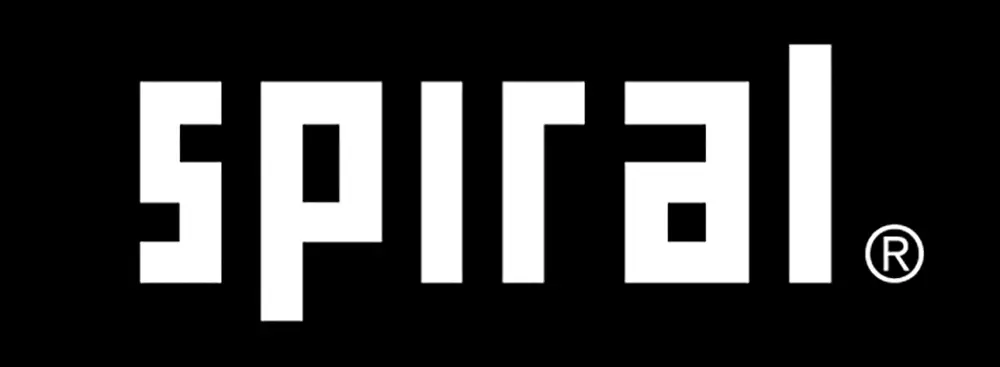
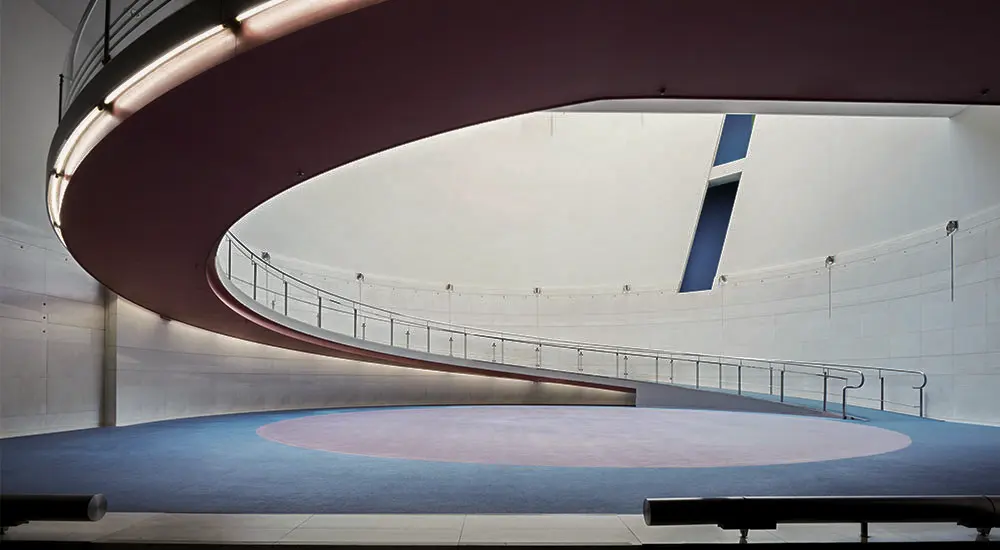
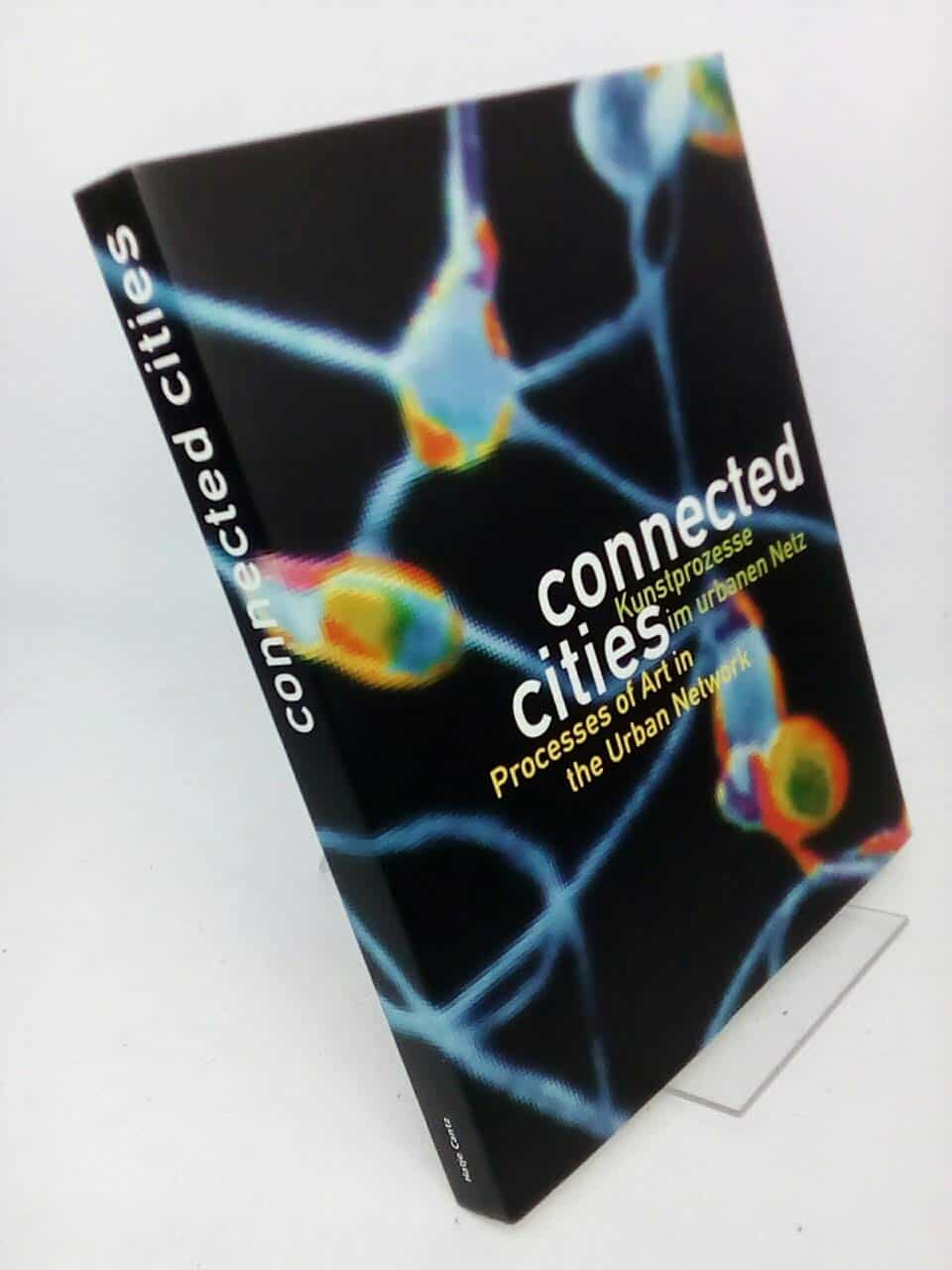
At the center of the multi-part and multi-room work “R111” (1999), a sensor-controlled sonic floor surface in the atmospherically dense cellar spaces generates internet data-fed architectures on a projection surface and monumental sound effects.
Andreas Denk, https://www.kunstforum.de/artikel/connected-cities/
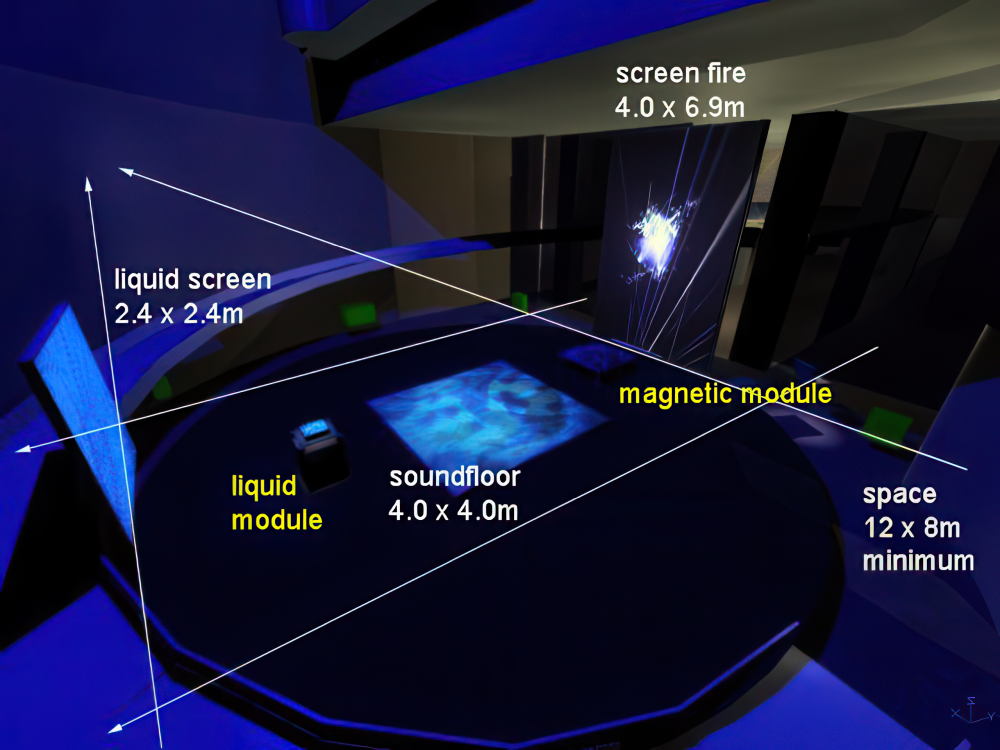
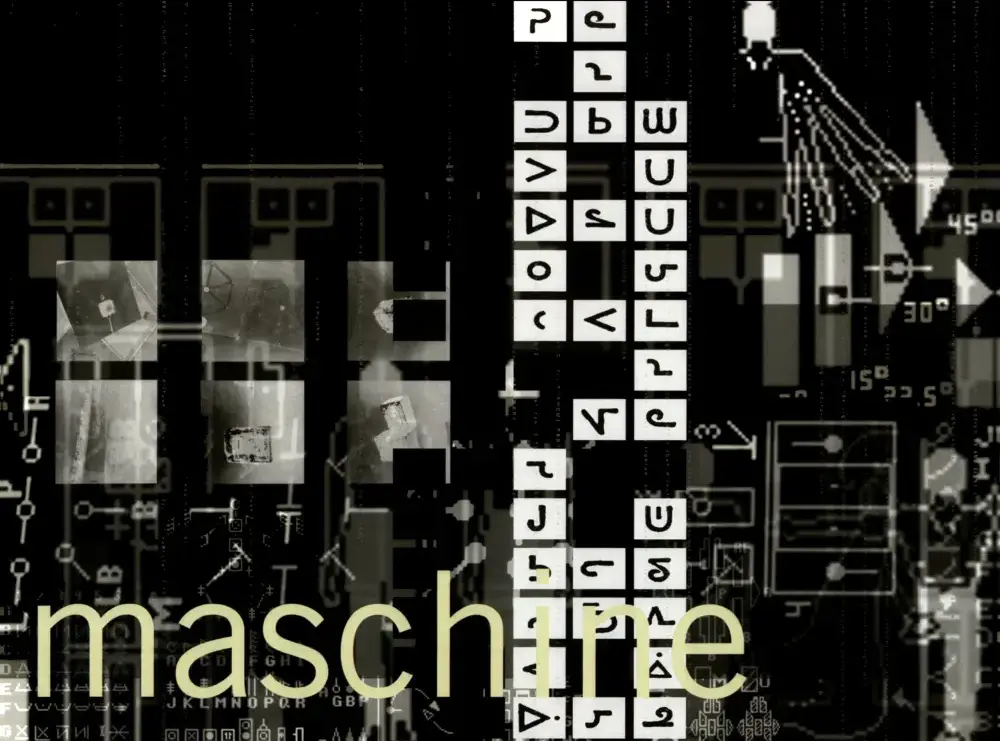
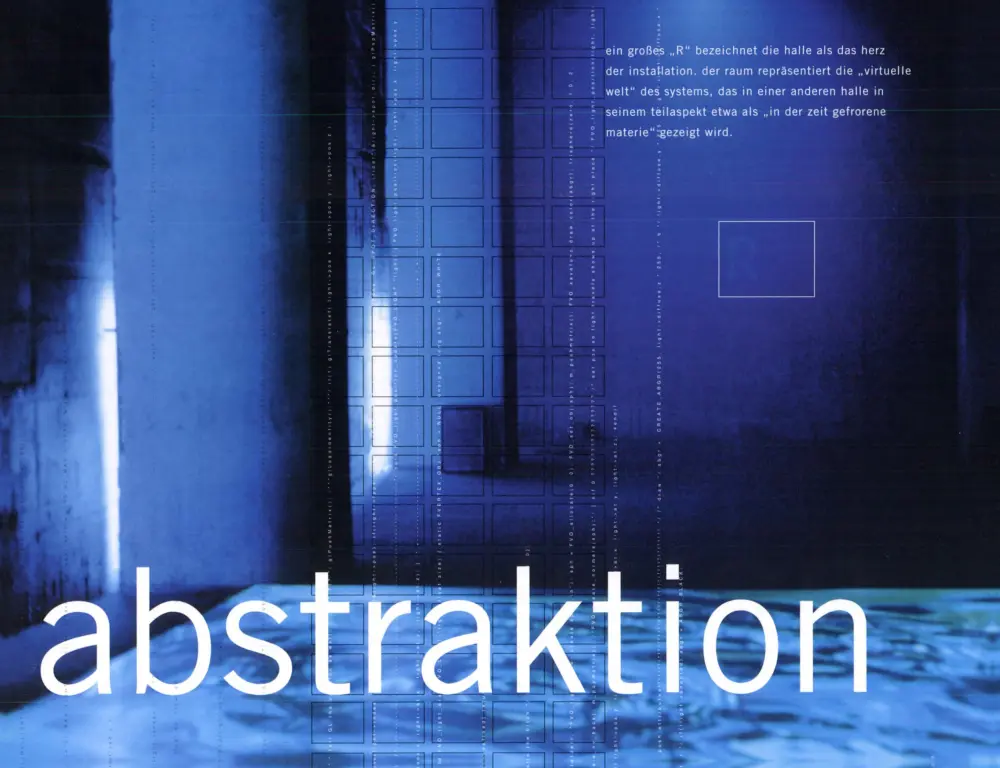
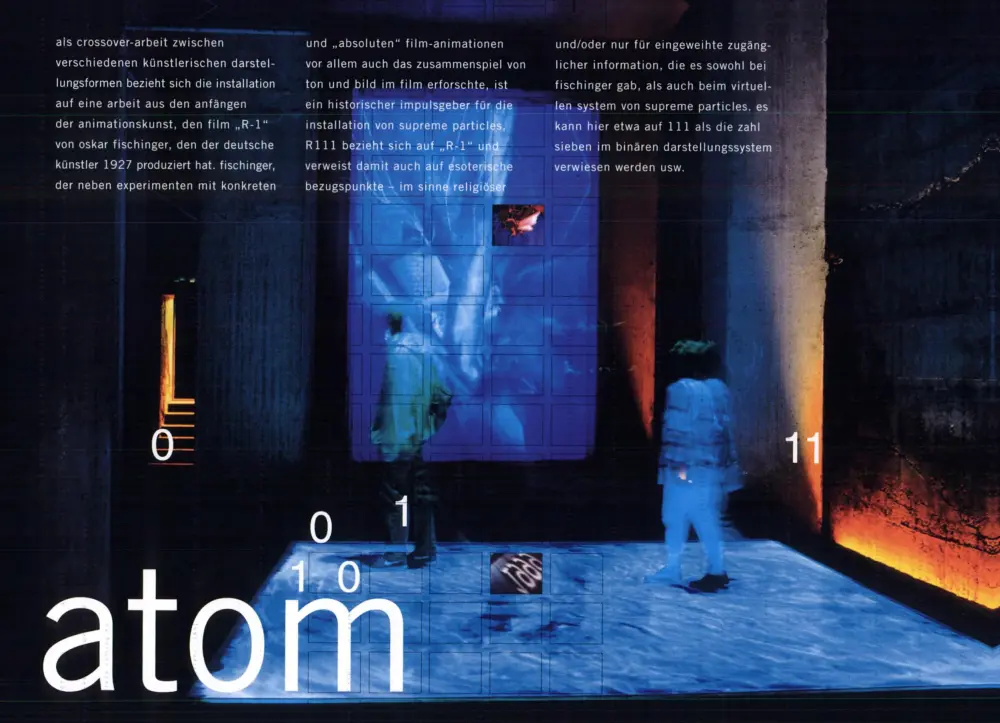
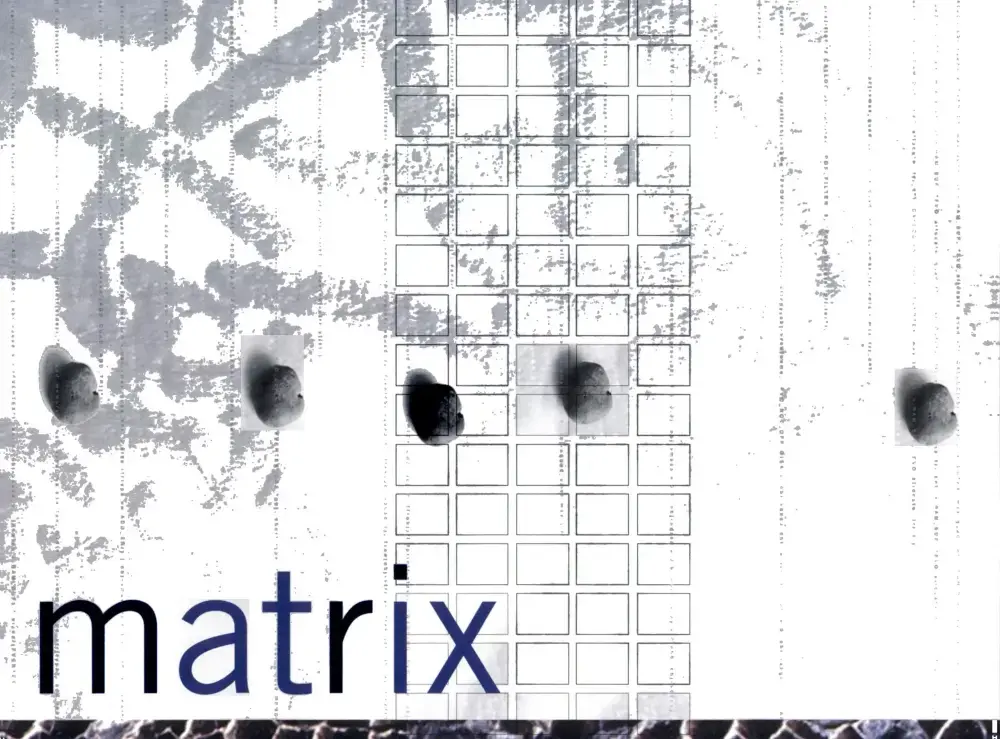
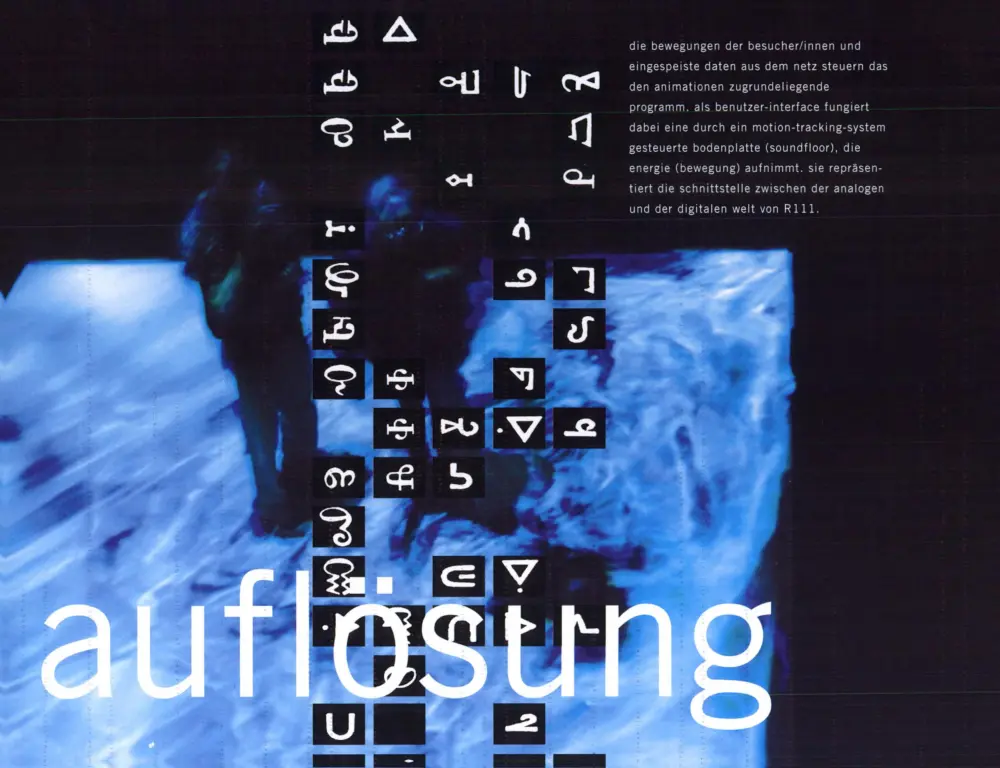
One thought on “R111 | 1999-2001”
Comments are closed.